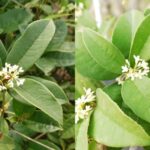The leaves are a vibrant green, and the flowers boast numerous petals in shades of white or pale yellow. The blossoms are a sight to behold, attracting both bees and butterflies with their beauty. The tree bears fruit in clusters; they are green when unripe and turn a gorgeous golden yellow as they ripen. These fruits have a tangy taste and are commonly consumed fresh as juice or syrup.

Not only are the fruits of the Barbados Gooseberry edible, but its leaves and flowers are also culinary delights, packed with vitamins and nutrients. They can be stir-fried, tossed into salads, paired with sunny-side-up eggs, and baked goods. Due to their high nutritional value when consumed, they are often referred to as the “poor man’s meat.”
Beyond its aesthetic appeal as a potted plant, the Barbados Gooseberry tree also serves a practical purpose. It can be planted alongside fences or walls as a natural barrier, thanks to its abundant thorns. This dual functionality makes it an excellent choice for those seeking both beauty and protection for their homes.

Ripe Barbados Gooseberries, showcasing their golden yellow color.
Cultivation and Care Tips for the Barbados Gooseberry
The ideal time to propagate this ornamental tree is during warm weather, typically late spring or autumn. You can either propagate it through cuttings or purchase young trees to plant in your desired location. Whether you choose to grow it in a pot indoors or outdoors, or directly in the ground along walls or in your garden, this tree requires minimal care.
However, for optimal growth, keep the following factors in mind:

– Soil: This tree thrives in well-drained soil to prevent root rot. Mix garden soil with coarse sand and pearl stones to create an ideal growing medium. Ensure excellent drainage by placing gravel or pottery shards at the bottom of the pot.
– Light: Barbados Gooseberries flourish in full sunlight. While they can tolerate partial shade, prolonged periods without sufficient bright light may hinder their growth and flowering. Therefore, it is best to position them in a sunny spot.
– Watering: This species prefers moist soil but can withstand short dry spells. Watering once every two weeks is ideal, aligning with its moderate drought tolerance.

– Fertilizer: During the growing season (spring, summer, and autumn), provide liquid fertilizer once a month. Fertilization is not necessary during winter. When repotting in spring or autumn, mix a small amount of slow-release fertilizer into the soil.
Use nitrogen-rich fertilizer during the seedling stage and phosphorus-potassium fertilizer before and after flowering. Keep fertilizer concentrations as low as possible. It is better to fertilize frequently with low-concentration fertilizer than with high-concentration fertilizer. If the roots turn yellow and growth slows, stop fertilizing immediately, as this may be a sign of over-fertilization.
– Pruning: Known for its thorny stems, the Barbados Gooseberry benefits from pruning at the end of winter. When pruning, remove dead or overly dense branches to improve air circulation, reduce the risk of disease, and promote flower and fruit development. Pruning also helps maintain the desired shape of the tree.
“The Ultimate Guide to Growing a Prosperous and Fragrant Mok Huong Plant”
The Bead Tree, also known as the Persian Lilac, is an enchanting evergreen that casts a spell of beauty and serenity wherever it grows. With its graceful branches and fragrant blooms, this tree offers a symphony of delights for the senses. Its flowers, borne in profusion, lend themselves to a myriad of uses, from brewing delicate teas to crafting exquisite baked goods. For those seeking to cultivate their own bit of paradise, the following guide will ensure your journey towards nurturing this magnificent tree is a rewarding one.



































